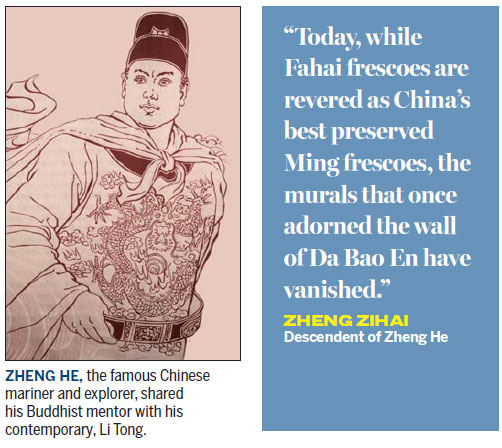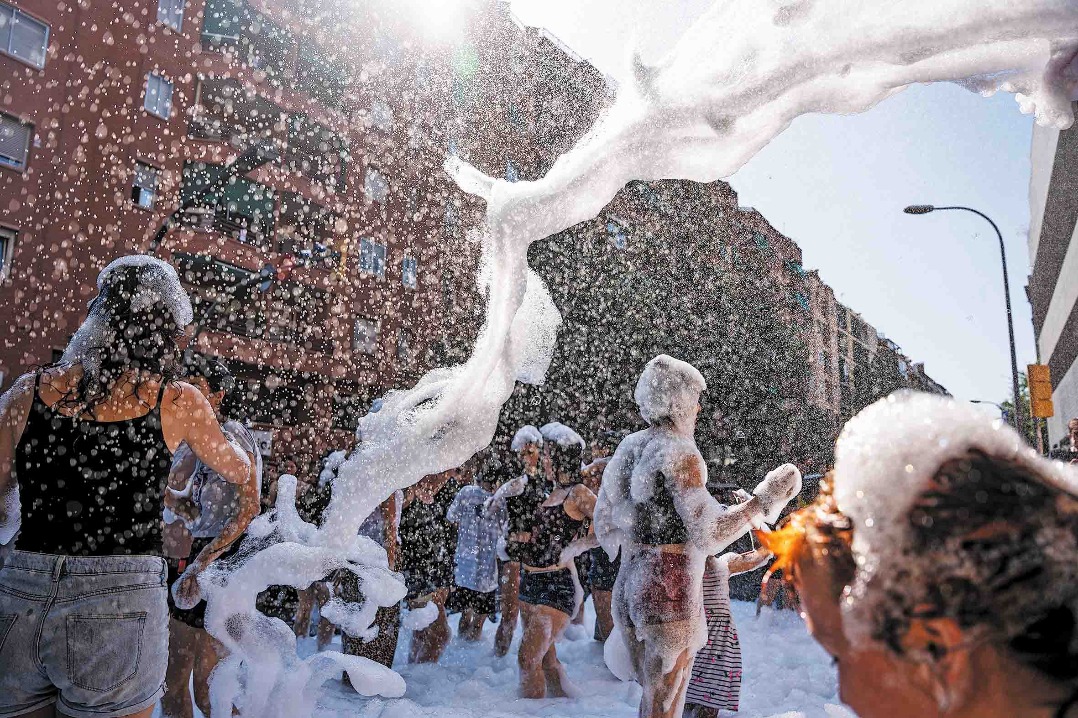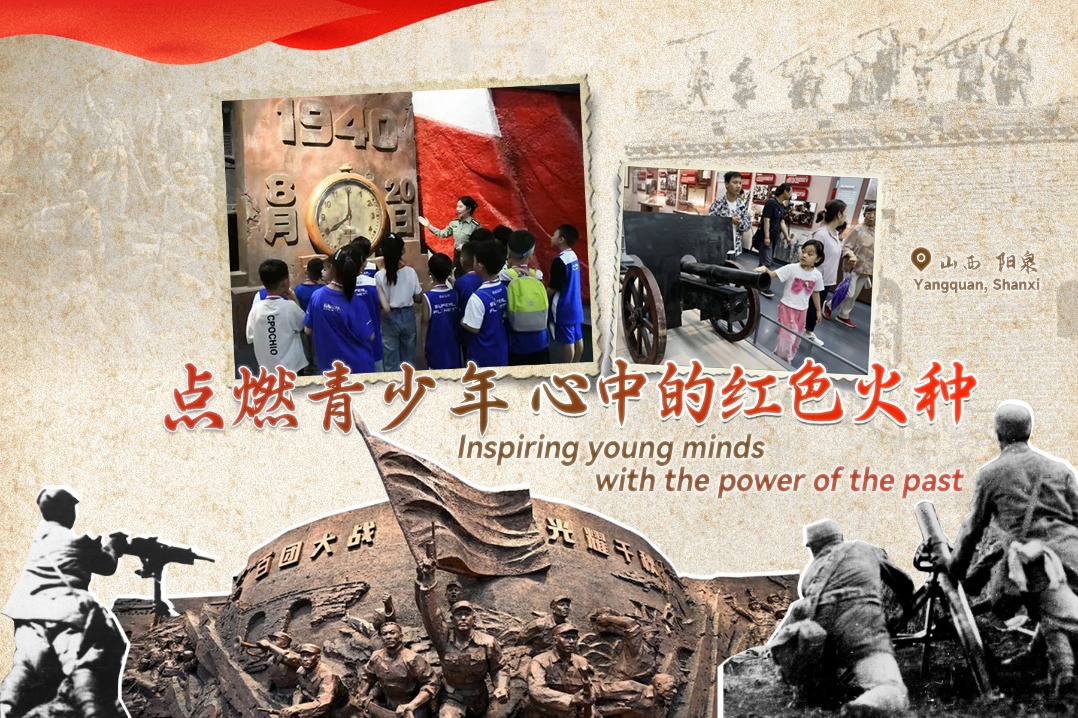Temple tells of ancient friendship

Clues reveal link between Fahai's founder and his friend, a Ming eunuch who was one of the world's greatest explorers
Every morning, Lu Shaojie parks her car beside a gravestone shaded by trees on the slope of Cuiwei Mountain in western Beijing, before going to work as a tour guide at Fahai Temple, just a few hundred meters to the northeast.
"Few people know about the tomb's existence, and even fewer people about its owner," says Lu, 55, pointing to the inscriptions not completely erased by time. "It belongs to Li Tong, the man behind Fahai Temple, who lived between 1389 and 1453."
| A copperplate printing of Da Bao En Temple in Nanjing, made by missionary artists in the 19th century. |
| Li Tong's graveyard in Beijing. Feng Yongbin / China Daily |

Apart from that, the only fact known for sure about Li is that he was a prominent eunuch of the Ming Dynasty (1368-1644). However, if one listens to Lu, the story of Li is inextricably linked to that of another man, the much more famous Chinese mariner and explorer Zheng He (also known in English as Cheng Ho), whose expeditionary voyages between 1405 and 1433 took his fleet to parts of Asia and Africa. Some of Zheng's ships are today believed to have been 120 meters long. Christopher Columbus' Santa Maria, by comparison, was 26 meters.
Ever since Zheng's story was spread more widely in the early 20th century, the mystique of the seafarer has been perpetuated partly by his being a eunuch of the Ming court. However, few people know that Zheng, who lived between 1371 and 1433, was a devout Buddhist. His religious pursuits eventually led him to share his Buddhist mentor with his contemporary, Li Tong, who was 18 years his junior.
According to Zheng Zihai, a descendent of Zheng He, his ancestor was Li's colleague for nearly 30 years. (Although Zheng He became a eunuch early in life, he did later adopt a son of his elder brother.) The two, both influential men in an era when eunuchs were given unprecedented power and had immense political sway, served three emperors together and became close.
Whether the friendship was due to mutual fondness or political convenience remains unknown. But they did have a faith, Buddhism, in common, something they also shared with successive Ming rulers. "Zheng He and Li Tong even bore the same religious name, Fushan, meaning benevolence and kindness," Zheng Zihai says.
The imperial blessing gave Buddhism a huge following during the Ming period. And it became a trend among powerful eunuchs, who had no blood heirs, to build temples. For childless eunuchs, these edifices could also function as ancestral halls, where they were venerated by pilgrims who had come to worship Buddha.
Zheng He died in April 1433, at 62, on the return leg of his final and seventh voyage. Some historians think his ashes were returned to his homeland when the fleet reached the Chinese coast in July of that year. Emperor Xuande, the Ming emperor of the day, ordered Zheng He's grand burial on a mountain slope in Nanjing. Zheng Zihai, who has done extensive research into his ancestor's burial, says Li was responsible for construction of a temple tower in Zheng He's memory.
In 1956, a gilt bronze miniature tower was unearthed in the underground chamber of the temple tower. But no connection was made between the bronze tower and the Fahai frescoes until Zheng Zihai visited the temple years later.
"In the fresco, a miniature temple held in the hands of a male god called Vaisravana bears a startling resemblance to the one excavated from Nanjing. Differences over the meaning of the inscriptions may never be resolved, but this visual connection offers proof that these two men were indeed related. In fact, I am tempted to believe that Li, an admirer of Zheng He, tried to honor the deceased first by inscribing his own name on the gilt bronze miniature and then by adopting that image for his beautiful frescoes."
And the tribute does not stop there, Zheng Zihai says. Between 1412 and 1428, under the supervision of Zheng He, a grand Buddhist temple was built in Nanjing and known as Da Bao En Temple, or the Temple of Gratitude. Emperor Yongle (1360-1424) ordered its construction to honor the late emperor and empress, who were founders of the dynasty.
"Today, while Fahai frescoes are revered as China's best preserved Ming frescoes, the murals that once adorned the wall of Da Bao En have vanished," Zheng Zihai says.
"However, according to the copperplate prints made by foreign artists in the 19th century, there used to be 118 rooms with murals in the precinct of Da Bao En, all splendidly painted with impressive detail.
"The construction of the Fahai Temple began in 1439, 11 years after Da Bao En was completed. Given the connections between Zheng He and Li Tong, it is highly likely that Li modeled his Fahai Temple frescoes on those of Da Bao En, especially when it came to murals. For those who dream of the grandeur of Da Bao En, more magnificent and majestic, the Fahai frescoes may offer a tantalizing glimpse."
And for those who have read about the evils of the Ming eunuchs, spending a few minutes inside the dark main hall of Fahai Temple, where the frescoes are housed, may open another window.
"Collectively, history - official and unofficial - has long painted the Ming eunuchs as a highly corrupt and greedy group, capable of not much except endless manipulation and incrimination. Many even blame them for the fall of the Ming 276 years after its founding, in 1644," says Lu, the tour guide. "However, the copious religious messages of this place assure me that Li was not merely concerned with saying a heartfelt thank you, or with his own afterlife.
"This man had Buddha in his heart," she says.
zhaoxu@chinadaily.com.cn
(China Daily European Weekly 04/15/2016 page17)
Today's Top News
- Xi sends congratulatory letter to Global Civilizations Dialogue Ministerial Meeting
- China harvests 149m tons of summer grain
- 38 new mineral deposits discovered in China this year
- There is no alternative to multilateralism
- Beijing ready to face US trade arrows
- Strategic autonomy of vital importance to EU
Most Viewed
- DeepSeek's success an opportunity for global AI cooperation
- 'Physical examinations' come to campus to usher in the new school term
- High-speed rail: Driving China's modernization
- China still key in driving global growth
- Medical assistance gives a boost to healthcare in Xinjiang
































